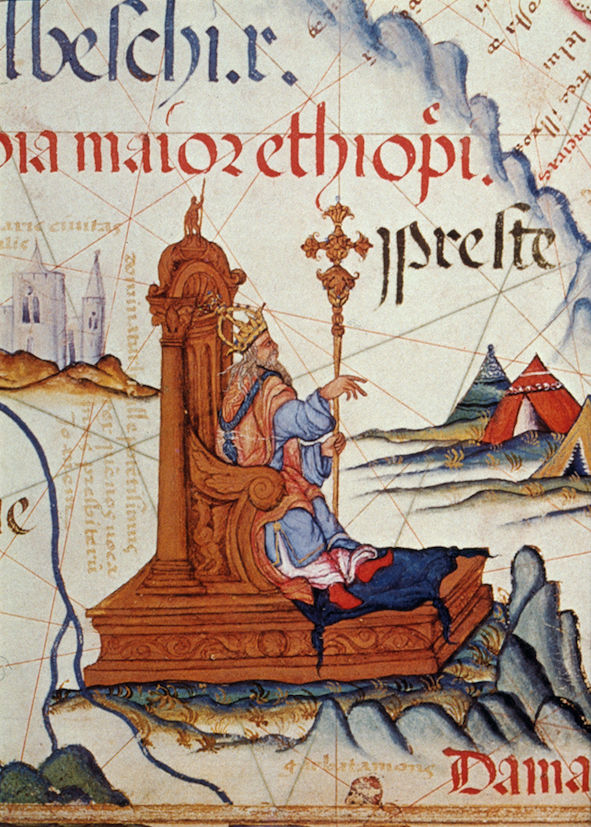
For several centuries during the Middle Ages, the Christian West looked to the East for a Christian priest/king who would save Christendom from the onslaught of Islam. Their hopes were dashed. The saviour priest/king never did arrive.
He was popularly known as Prester John, also referred to as Presbyter John or John the Elder. He was believed to be a Nestorian Christian and ruled over a wealthy kingdom ‘far beyond Persia’.
The first mention of Prester John appeared in the Chronicle of Bishop Otto of Freising in 1145, which in turn was based on a report by Bishop Hugh of Gebal (modern Jbail in Lebanon). Hugh reported that a powerful and wealthy priest/king:
‘said to be of the ancient race of those Magi who were mentioned in the Gospel, and to rule the same nations as they did, and to have such glory and wealth that he used only an emerald sceptre’, had defeated the Muslims at Ecbatana.
It is thought that this might have been the battle that had taken place at Qatwan, near Samarkand in today’s Uzbekistan when the Seljuk Sultan Sanjar suffered a major defeat at the hands of the Mongol khan Yelu Dashi. Having defeated the Muslim Seljuks, Bishop Hugh claimed that Prester John then planned to proceed to Jerusalem. But his plans were thwarted when his troops found they were unable to cross the waters of the Tigris River.
Yelu Dashi was the founder of the Mongol Karakitai empire and his official title was Kor-khan. It has been speculated that ‘Kor-khan’ was changed phonetically into the Hebrew Yohanan and from there to the Latin Johannes, or John. Although the Karakitai were predominantly Buddhist, some of their leaders were Nestorian Christians and many had Christian wives. It was thus a short step to confusing a Mongol khan with the mysterious Christian King Prester John.
It is also possible that the visit of Patriarch John of the Indian Church of St Thomas to Rome in 1122, helped fuel the rumours of the existence Prester John. Patriarch John had boasted of the wealth and beauty of his homeland in India and implied that he was the temporal ruler as well as spiritual ruler of his See.
In 1145, the Christian West was in desperate need of an ally against the onslaught of the Seljuk Turks. The Crusader kingdom of Edessa had just fallen to Seljuk general Zengi, so marking the end of the Second Crusade and the city of Jerusalem was in grave danger of being attacked by the Seljuk Muslims. So, when reports reached the Pope that a Christian king from the East had defeated the Muslims at Ecbtana (Qatwan) and was now making his way towards Jerusalem, hopes were raised that aid was on its way.
When Prester John and his army failed to arrive, hopes in a ‘saviour’ army began to fade. However, in 1165 spirits were raised again when the Byzantine Emperor Manuel Comnenos, the Holy Roman Emperor Frederick Barbarossa and the Pope, all received letters from Prester John. The letter, which was probably a piece of propaganda in support of a Third Crusade, was in fact a forgery. Despite this, for several centuries, it was widely circulated and over 100 copies, in various languages are still in existence.
Jerusalem finally fell to Saladin in 1187 at the time of the Third Crusade and the Fourth Crusade ended in the disastrous Sack of Constantinople by the Crusaders. However, by the time of the Fifth Crusade, which landed in Egypt in 1218, once more hopes were raised that help was on its way. An ally from the East had defeated the Muslims and was not far from Antioch. The Crusaders believed this to be King David of India, a descendent of Prester John. In reality it was probably the Mongol general Abaqa Khan, son of Hulagu Khan, and a staunch enemy of the Seljuks.
When the Crusaders were finally ousted from the Levant by the Mamluks in 1291, the search for Prester John moved from the Holy Land to Abyssinia where a Christian community had been in existence since the 4thCentury. It was rumoured that when the priest/king had been defeated in Central Asia by the Mongols, he had moved to Abyssinia where he became King and continued his fight against the Muslims.
Although no longer believed to be fabulously wealthy, the priest/king was still valued as a potential ally in the fight against Islam. He never appeared in Abyssinia but the search continued under the Portuguese. At the time of the Voyages of Discovery, Prince Henry the Navigator instructed all those who sailed down the coast of West Africa to travel inland and look for the mysterious king. This continued until the epic voyage of Vasco da Gama in the 15th Century, on his journey to the Indies.
By the 16th Century few people believed in the true existence of Prester John. The priest/king became a legend and has survived in the imagination of travellers, writers and film-makers to this day.
*****
Comments